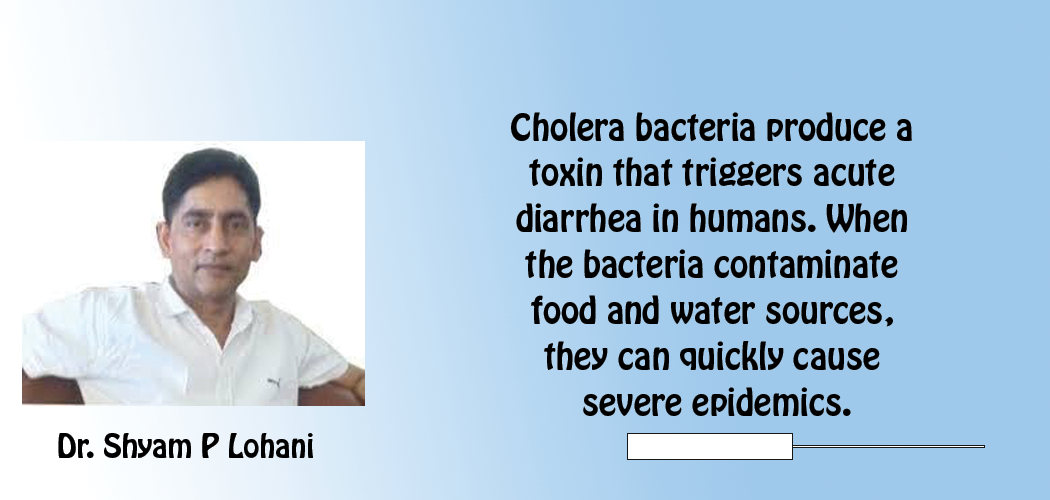- Monday, 28 April 2025
Stem Risk Of Cholera Outbreaks
Dr. Shyam P Lohani
Some cholera incidences have been reported in Nepal with the beginning of monsoon. It is endemic to many parts of the country, including the Kathmandu Valley. Cholera is an acute diarrheal infection. If left untreated, it can be fatal within hours. It has been estimated that each year there are 1.4 to 4 million cases of cholera, and over 100,000 deaths worldwide due to cholera (WHO, 2022).
Cholera causes severe dehydration, hence fatality rates are high especially among children and infants if left untreated. Death can occur even in healthy adults within hours. It has been found that people who recover usually have long-term immunity against re-infection. The disease is most common in places with poor sanitation, and overcrowding. Several parts of Africa, South Asia, and Latin America reports epidemics of cholera each year.
Infection
The cause of cholera is infection by the bacteria named Vibrio cholerae. Most people infected with V. cholerae remain asymptomatic, although the bacteria are present in their faeces for 1-10 days after infection. Those bacteria are shed back into the environment that may lead infection to other people. Only around five per cent cholera infections cause severe effects, and a high percentage of infected people remain asymptomatic.
The common places where V. cholera bacteria live are shallow, salty water on microscopic crustaceans. The bacteria can exist as colonies of biofilms coating the surface of the water, plants, stones, shells, and similar items that serve as a reservoir for cholera bacteria. Cholera bacteria produce a toxin that triggers acute diarrhea in humans. When the bacteria contaminate food and water sources, they can quickly cause severe epidemics.
The symptoms appear between 12 hours and five days post exposure. The infection ranges from mild or asymptomatic to severe in nature. They typically include large volumes of explosive watery diarrhea, sometimes called rice water stools because it can look like water that has been used to wash rice, vomiting, and leg cramps.
A person with cholera can lose massive amount of fluids, up to 20 litres a day, so severe dehydration and shock can result. Signs of dehydration include loose skin, sunken eyes, dry mouth, decreased secretion, for example, less sweating, fast heartbeat, low blood pressure, dizziness or lightheadedness and rapid weight loss. Shock is a life-threatening condition and need emergency medical support.
Cholera bacteria enter the body through the mouth, often via contaminated food or water with human waste, owing to poor sanitation and hygiene. Poorly cleaned vegetables irrigated by contaminated water sources are another common source of infection. In place and situations where sanitation is severely compromised, such as in refugee camps, slums or communities with highly limited water resources, a single affected victim can contaminate water sources that may affect an entire population.
People most at risk of contracting V. cholera through contaminated food and water include people who work in healthcare and treat individuals with cholera, relief workers who respond to cholera outbreaks, people who are travelling in areas where cholera outbreaks occur each year. Wide-spreading epidemics of cholera often occur due to water supplies that are contaminated with human waste and also through street food vendors.
The people at risk of a more severe reaction to V. cholera than others are people with achlorydia, a condition that removes hydrochloric acid from the stomach, individuals with blood type O, people who have chronic medical conditions, those without access to ORT and other medical services. Therefore, effective hygiene measures can help reduce the risk presented by cholera.
Management
If cholera is suspected, a stool sample is sent to a laboratory for testing. However, the patient must begin treatment even before the results come back. Severe dehydration due to cholera can lead to death, therefore most important treatment is water replacement with oral hydration solution (ORS), popularly known as oral rehydration therapy (ORT). ORT can also be prepared at home with common household ingredients.
Severe cases of cholera require intravenous fluid replacement. It has been estimated that an adult weighing 70 kilogrammes will need at least seven litres of intravenous fluids in case of severe diarrhea due to cholera infection. Antibiotics can shorten the duration of the illness. However, the WHO does not recommend the mass use of antibiotics for cholera due to increased risk of antibiotic resistance. Anti-diarrheal medicines are not used because they prevent the bacteria from being flushed out of the body. The fatality due to cholera is around one per cent if prompt and proper treatment is provided.
Cholera is often spread through food and is associated with poor hygiene. Simple measures in our house or community can reduce the risk of contracting cholera. It is important to eat only fruit that is peeled, avoiding raw salads, raw fish, and uncooked vegetables, and ensuring that food is thoroughly cooked, and making sure water is boiled and safe to consume. It is equally important to avoid street food, as this can carry cholera and other diseases.
(Dr. Lohani is a clinical director at the Nepal Drug and Poison Information Centre. lohanis@gmail.com)
















